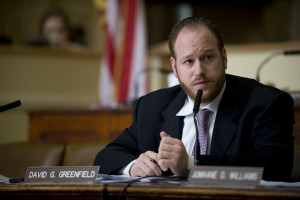
Councilmember David Greenfield, chair of the Committee on Land Use. Image credit: William Alatriste/New York City Council
City officials questioned on policy to protect New York’s industrial sector. On May 6, 2015 the City Council Committee on Land Use held an oversight hearing on industrial land use policy in New York City with a focus on protecting and encouraging the City’s industrial sector from encroaching alternative uses. In his opening remarks, Councilmember and Land Use Chair David Greenfield emphasized as ineffective the City’s policy of designating Industrial Business Zones without changing the underlying zoning to protect industry from competing commercial uses and pointed out the importance of protecting the City’s industrial sector, comprising 10 percent of the local private sector workforce, frequently made of small businesses employing forty people or less, and paying significantly higher wages than the service sector.
Small Business Services Commissioner Maria Torres-Springer testified on ways SBS is working to support industrial businesses already in place, including an exploration of using Business Improvement Districts to provide tailored services to industrial sectors. City Planning Commission Chairman Carl Weisbrod testified on Mayor Bill de Blasio’s commitment to improving the Hunts Point Food Terminal in the Bronx, labeling it “one of the City’s most important industrial areas”. Mr. Weisbrod stated the city will invest $150 million over twelve years to modernize Hunts Point’s buildings and infrastructure, open up new small business space, and improve flood resiliency. The chairman also testified the Department of City Planning would explore new prototypes for mixed-use districts that promote compatible industrial or manufacturing uses over the long term, arguing not all such uses were totally incompatible with commercial and even residential use, and proposed DCP undertake a comprehensive land use study of the North Brooklyn industrial area. “North Brooklyn has great potential for more careful considerations of the way the city treats its M zones,” said Mr. Weisbrod. President of the New York City Economic Development Corporation Kyle Kimball testified on EDC’s policy under Mayor de Blasio to leverage City-owned assets in industrial sectors for promoting job growth, citing leasing space in the Brooklyn Army Terminal to more job-intensive firms rather than to just anyone that could pay the rent.
In submitted written testimony, Brooklyn Borough President Eric Adams called for affordable and worker housing near, but not inside, the industrial zones. “We need to grow our options for affordable and worker housing in these areas, so current residents can stay and people moving in for jobs can find a place to live that is within budget.” The borough president also called for expanded transportation infrastructure to connect workers to IBZs, from ferry and full-build Bus Rapid Transit to safer pedestrian and bicycle pathways.
Councilmember Rafael Espinal began the questioning by asking about City Planning’s East New York rezoning taking place adjacent to the East New York Industrial Business Zone, both areas he represents. The councilmember stated the area was fertile for job development, arguing “If we’re going to bring seven thousand units [of housing] into the neighborhood, we should look at bringing in seven thousand jobs at least.” Mr. Weisbrod testified City Planning has been careful to not look at the IBZ in the rezoning process because of its potential for jobs, while Mr. Kimball testified on details of how EDC was working to enhance and support businesses in the East New York IBZ.
Councilmember Greenfield argued the IBZ designations made under former Mayor Michael Bloomberg had no impact as the underlying M zoning still permitted non-industrial uses as-of-right including retail, hotel, and self-storage and asked about specific proposals the Council had previously proposed to solve the issue. Mr. Weisbrod testified there was a lot of common ground between the Council proposals and what City Planning was working on and stated a challenge they face going forward is a lack of detailed data on what’s happening in IBZs, arguing most of what’s promoted is anecdotal evidence. Mr. Kimball testified it’s important to think there are different types of industrial economies, and it’s possible for creative and industrial economies to coexist in a tight space. Councilmember Brad Lander argued IBZ tenants were seeing displacement from increasing rents, but Mr. Weisbrod repeated the concern over a lack of detailed data on what’s happening in IBZs, expressing a reluctance to issue sweeping policy changes in a “one size does not fit all” situation.
Several councilmembers joined Councilmember Greenfield in pushing for a commitment from City Planning that IBZs would not be rezoned, citing increased developer speculation in IBZ properties. Councilmember Antonio Reynoso stated $29 million worth of properties have already been bought in the North Brooklyn industrial area by developers anticipating rezoning for more lucrative residential building, with more ongoing. Councilmember Carlos Menchaca stated he and other councilmembers consistently receive requests to evaluate housing development proposals in M3 zones “out of any kind of context and scope”, and argued the developers are encouraged by City Planning’s lack of plan protecting IBZs. Mr. Weisbrod stated City Planning has “no contemplation in any way” of large area rezoning of IBZs, stating less than fifty acres in all M zones in New York City have been rezoned in the last sixteen months, most of those taken up by the Astoria Cove development. However, the chairman cautioned “I’m certainly not going to say that there will never be an inch of an IBZ that conceivably could not be rezoned,” mentioning City Planning was looking at areas on the periphery of IBZs as well as areas that should not have been part of the IBZ boundary to begin with.
City Council: Public Hearing (May 6, 2015).
By: Michael Twomey (Michael is the CityLaw Fellow and a New York Law School graduate, Class of 2014)

